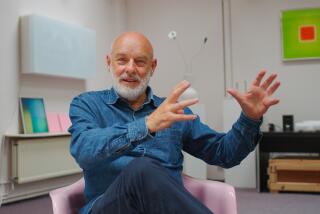BOOK REVIEW : Giving Voice to Science’s Mavericks
- Share via
Discovering: Inventing and Solving Problems at the Frontiers of Scientific Knowledge by Robert Scott Root-Bernstein (Harvard; $35; 501 pages)
Thomas Mann says people are divided between burghers and artists, cautious townsmen and creative spirits. One says, “Be reasonable,” and the other says, “Be unreasonable.” It’s a matter of temperament, and there are many more of the first kind of person than of the second. But the world needs both.
“Discovering,” by Robert Scott Root-Bernstein, is an eloquent paean to the artists in science, the mavericks, misfits and free spirits. It is also an indictment of the current institutional structure of science, with its funding committees, peer reviews and demand for conformity. Under the present setup, caution is rewarded and new ideas are stifled.
Befitting its message, “Discovering” is an unusual book. It is written in dialogue form, with six characters meeting over several weeks to talk about creativity and to try to understand it. This format enables Root-Bernstein to put various ideas in the mouths of his characters without necessarily endorsing them.
It also allows him to explore, brainstorm and toss out ideas without having to make a formal argument, which is very much what the book calls for in creative thought. As a result, “Discovering” is both an extended discussion of that point and an example of it.
Root-Bernstein is an associate professor of physiology and natural science at Michigan State University and a former winner of a MacArthur Award--the “genius award”--from the MacArthur Fellows Program. He has written extensively on the subject of creativity, and here he draws together his extensive thinking on the subject. The result is an intriguing and extraordinarily important book.
“Most pioneering or breakthrough scientists would not have been able to curry favor under our present system,” one of his characters observes near the end. “As far as I can tell, almost every major discovery has resulted from crackpot ideas or attempts to solve ‘impossible’ problems that no one took seriously at the time.”
Another character observes: “If we clone scientists, we will produce cloned science. Clones are economical to produce but infuriatingly uniform in their patterns of work and thought, as the Soviet Union and Japan have found out. These nations produce many scientists, but few scientific breakthroughs. Science can never be organized like an assembly line. Unlike industry, it must strive for maximum diversity, not maximum uniformity.”
Root-Bernstein bolsters the point throughout the book with many historical examples and case studies. Progress is made by loners who shun the crowd--and its rewards--and insist on following their hunches and pursuing their insights.
Such people rarely get warm receptions from the Establishment. As a result, they suffer for their choice. A large number of creative people experience depression. “These depressions and breakdowns seem to be related to a striving type of personality,” one of the characters says. “It’s not easy to be or to act differently from everyone else, but you can’t create if you conform.”
The great advances in science are rarely made by people at blue-chip academic institutions, Root-Bernstein says. Einstein was a clerk at the Swiss patent office when he did his most important work in physics. And he is not a unique example. The people at the “important” places have internalized the status quo and have become cautious. That’s how they got to be full professors at Harvard at age 35. The mavericks are elsewhere.
The book explores whether creativity can be taught, and if so, how? It argues that discovery is a process, not an end, and it urges schools to teach broadly rather than narrowly.
“One of the common themes running through the education of all creative people is an early experience with the creative process itself,” one of the characters says. “It doesn’t matter whether it’s in poetry, music, painting, crafts, inventing or science itself: The act of creating something for yourself is an assertion that you are not afraid to test yourself against tradition, or to express your personal view of the world, despite the perils of any such endeavor.”
How to implement such an educational program is another matter. Just as most people wind up being plodders, most teachers are, too. Schools have been urged to foster creativity at least since the days of John Dewey--without wide success. The drive for conformity begins in schools.
The only problem with Root-Bernstein’s book is that he makes it seem that every crackpot is right, which is hardly the case. People with new and important things to say are likely to be shunned, but that does not mean that everyone who is shunned has new and important things to say. Most of them don’t, but you wouldn’t draw that conclusion from Root-Bernstein’s book.
The problem is how to know in advance which of the cacophony of crackpots is right. Every single one of them claims to be the new Galileo.
But that caution aside, this book is a major contribution to understanding the creative process in individuals and institutions. It is a work of great insight and sweep, and it should be the manifesto of great changes in education and science.
Maybe it will be. Maybe.
More to Read
Sign up for our Book Club newsletter
Get the latest news, events and more from the Los Angeles Times Book Club, and help us get L.A. reading and talking.
You may occasionally receive promotional content from the Los Angeles Times.










